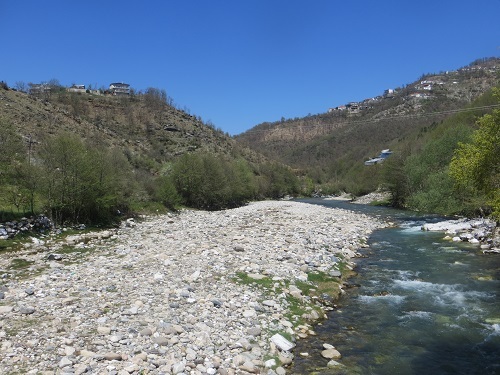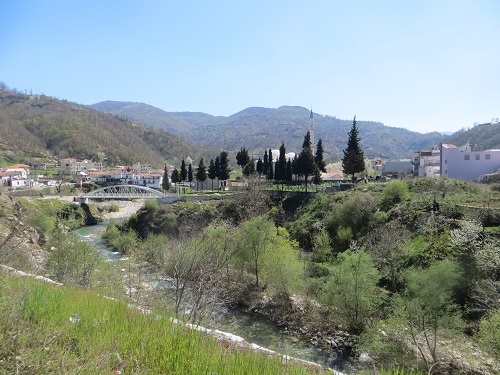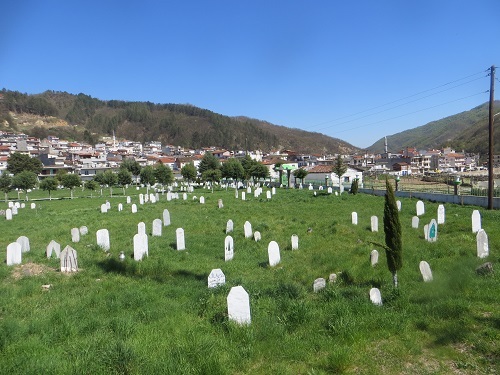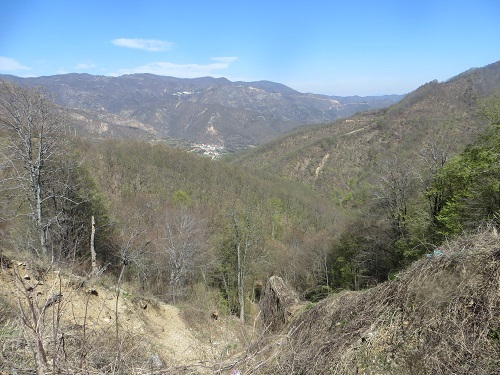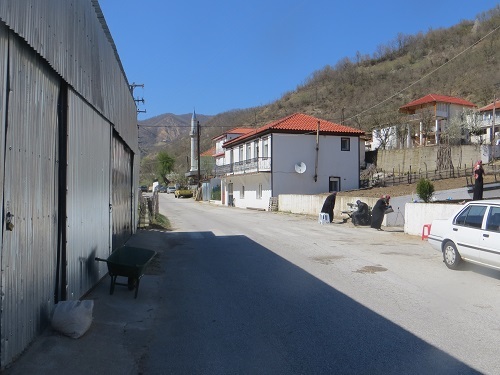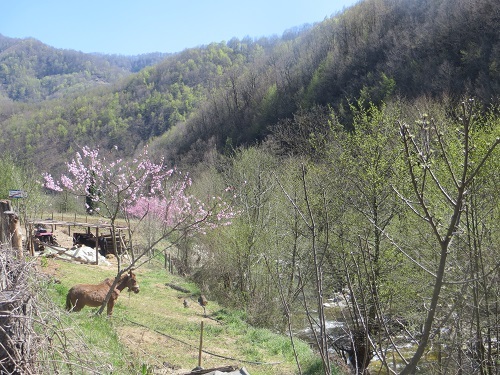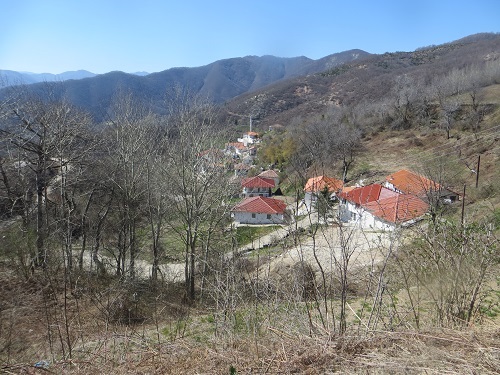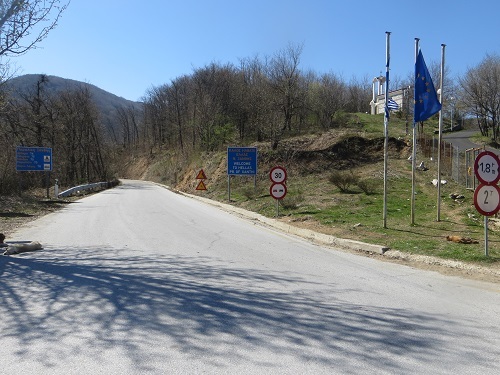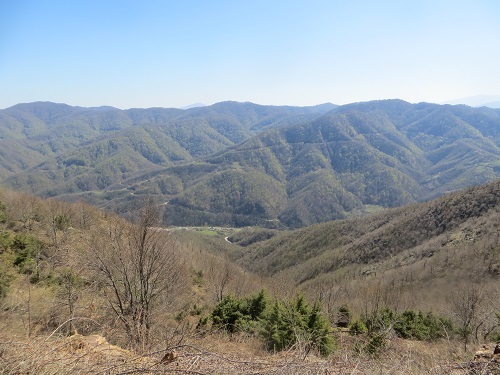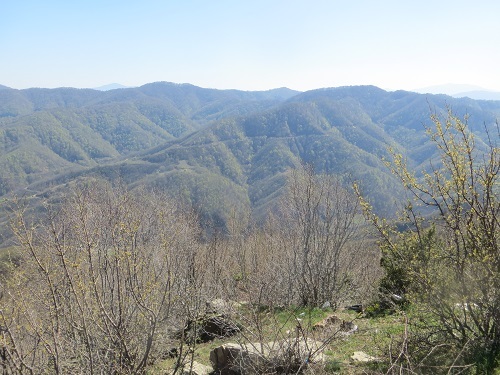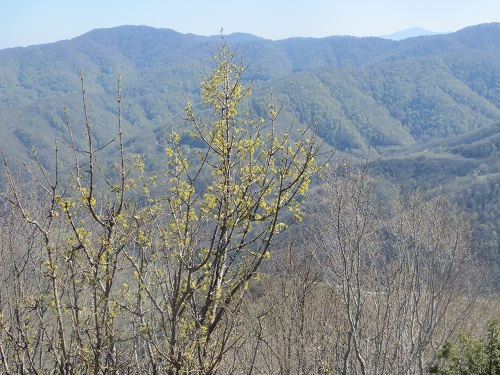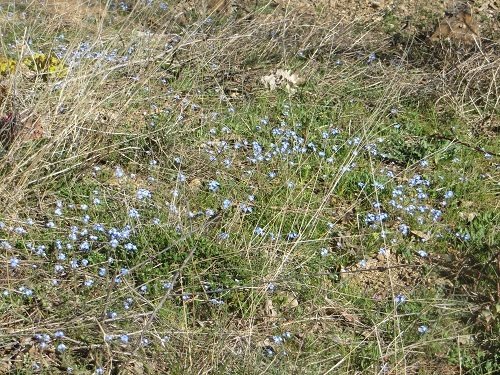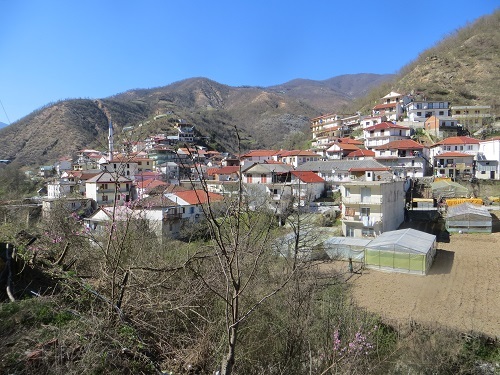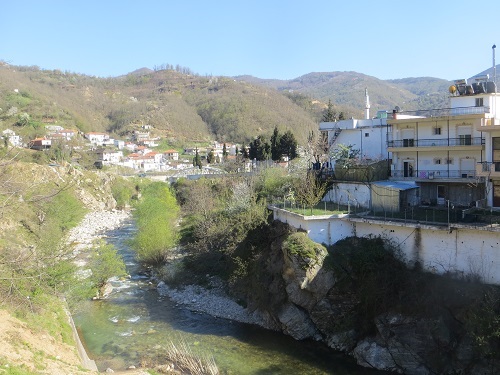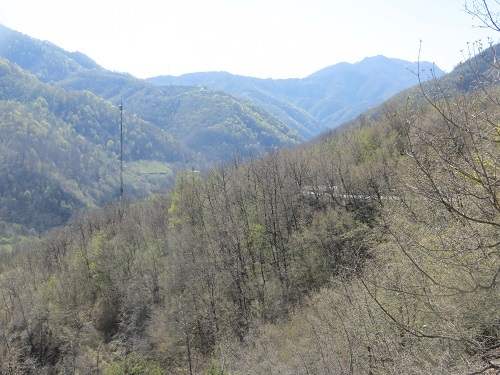They're called Pomaks and according to Lonely Planet their 'ethnic identity is a subject of some uncertainty, even to themselves.' But they are generally believed to be Bulgarians who converted to Islam from the early 15th century. Here in Greece they speak Greek, Bulgarian and Turkish, and their women generally wear head scarves and full length abayas.
Be that as it may, they inhabit a somewhat remote area called Pomakohoria north of Xanthi in Thrace, a couple of dozen picturesque mountain villages of whitewashed red-roofed houses, all with characteristic Ottoman-style mosques with spindly minarets topped by dunce's caps, here in blue. Perhaps we should be more charitable and call them wizard's hats.
To add to the allure the whole area is within the Rhodope Mountains and I've managed to get a taxi for only $53.83 for a 3 ½ hour trip in late April.
Smynthi, the first Pomak village we come to, strides a river in a verdant ravine, two slender minarets topping its red roofs. Echinos, Pomakohoria's main village, clambers up a hillside, Thermes with its hot springs in a mountain bowl is split into three (upper, middle and lower), and Kidaris sleeps in a valley within a stone's throw of the Bulgarian border.
It's all very bucolic, flocks of sheep, shepherds, tumbling streams, waterfalls. It's in Middle Thermes that things start going awry. A man's waving his arms like an unhinged windmill and bellowing bloody murder.
Well, it's Giorgios the driver's fault. He said I could take photos. I thought something was amiss when the scarved ladies started turning their backs and skittering away, abayas in full spate. After much screaming we escape with our lives up to the top of the peaks.
Now it's the scenery that takes our breath away. Up here this is the land of the Karadere, Turkish for black forest. Wave after wave of forested ocean swell across ridge, fold, summit and valley, the green awakening of early spring glinting in the brilliant sunshine under a cloudless blue sky.
Pure peace and paradise now. But during the cold war the whole area was closed. A tarred road to fellow European Union member Bulgaria and a border post was opened three years ago.
My attempts at a Robert Capa moment at the frontier are met with a wagging finger and a very much verboten bark, but I'm allowed to snap away from the post towards the board saying welcome to Greece.
Back down on the Thracian plains it's the Via Egnatia that has been reborn. First built in the 2nd century B.C., all 696 miles of it, it stretched from Dyrachium, stop-off point for boats from Rome and now called Durrës, across what is now Albania, Greece and European Turkey to Istanbul, then called Byzantium.
Along it marched the armies of Julius Caesar and Pompey in that nice little civil war they had, and a little later those of Mark Antony and Octavian (Augustus) as they hot-rodded after Cassius and Brutus for gutting Caesar and thereby giving Shakespeare an excuse to write 'O pardon me thou bleeding piece of earth.'
Today, same name but different material, the Egnatia Odos, as it is called in Greek, runs pretty well the same circuit between Thessaloniki and the Turkish border, and on this bright spring morning Yours Truly is making his own way from Xanthi to Alexandroupolis, not by quick march à la Augustus, but by a comfortable, almost empty off-season bus.
The towering grey crags of Rhodope surge up on the left, a massive wall of ridges and folds pushing back into V-shaped valleys, more barren than those to the north of Xanthi. On the right the Thracian plain displays its aptitude for agriculture with fields of many colours - ploughed brown, green with plants, and brilliant yellow with flowers.
Road signs warn of strong side winds, and at a toll station demonstrators brandishing red flags with the yellow KKE letters of the Greek communist party are warning about Gawd knows what - you'd have thought they would have learned better by now.
Muslim villages with their tell-tale dunce's cap-topped minarets cling to the foot of the Rhodope, occasional shepherds tend their flocks, and on the right the saw-toothed, snow-streaked peaks and ridges of Samothrace, some 25 miles off shore, thrust up against a hovering crown of thick white clouds.
Once in Alexandroupolis, port for the Samothrace ferry, a disappointment awaits. I was hoping this would turn out to be a daylight version of Ben Stiller's Night at the Museum, with mysterious ancient Thracians coming to life and stepping out of dioramas, at least in my mind's eye, as Lonely Planet says Alexandoupolis's Ethnological Museum of Thrace displays Thracian traditional customs.
What in fact is going on is that I'm learning how to make indigo dye, get clothes to shine with bees' wax and corn starch, and manufacture ice cream in huge copper bowls that I had once seen in practice in Mazar-i-Sharif in Afghanistan.
Most important, I've learned how to dress as a Sarakatsan man with a frilly, fluted, flaring, flouncing white skirt, huge pompoms on mocassins, embroidered waistcoat bordered in crimson, a very wide cummerbund, a white tunic, and a round beret-type hat.
I'm sure I'd look most fetching. I've also learned to recognise Pomak iron bellows and scoped huge wooden pitch forks that will suit me nicely when I descend to hell - except that they'll already burn up.
All this, however, is not why I've rushed to the museum from the bus station before the ferry leaves. I should have read on. LP explains that the exhibits are not about the ancient Thracians at all but of the life-styles of the last century or so.
Still, all is not lost. The museum is interesting in its own way and has an excellent film on Thrace, its history, ruins, towns, customs, and scenery.
Thracian mountain scenes
______________
By the same author: Bussing The Amazon: On The Road With The Accidental Journalist, available with free excerpts on Kindle and in print version on Amazon.
